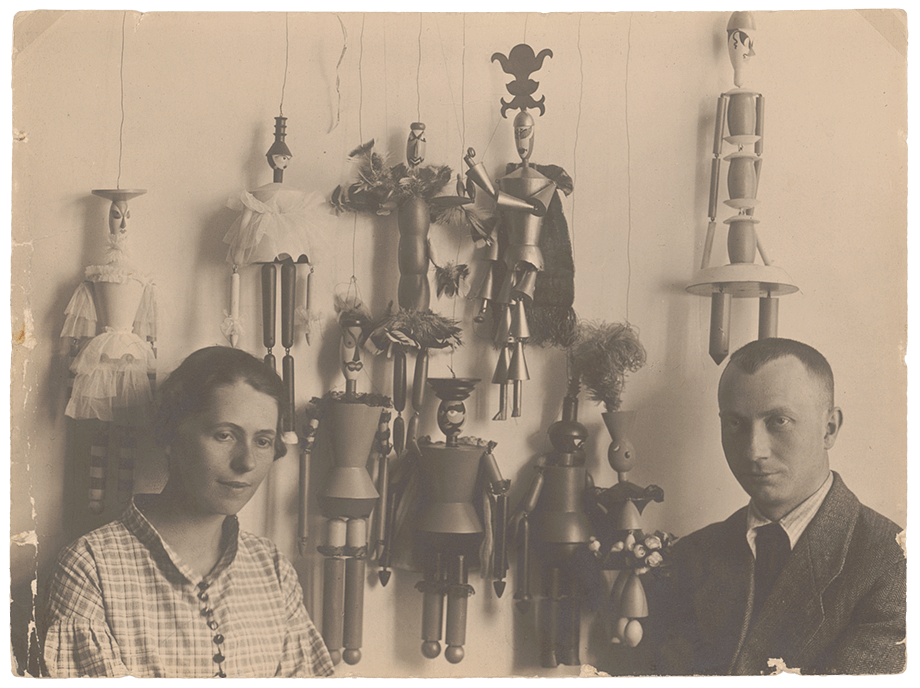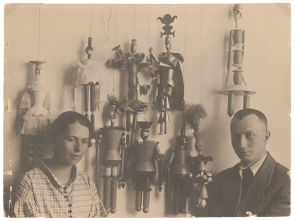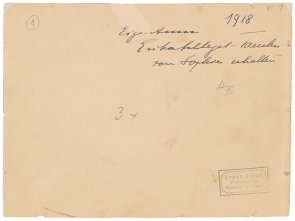The photo is a rare document from the Zurich Dada period; generally, few historical photos are still extant today. Ernst Linck, whose photo studio was next door from Café Odeon, undertook the job of taking all the photos of the string puppet production of King Stag. In respect to subject matter, the photo is the documentation of a work; however, even more fascinating in it are the puppet-making artist, Sophie Taeuber, and Hans Arp himself. His look wants to be reciprocated, and her gaze sends us on a search. They met in 1915 at the Galerie Tanner and got married in 1922. Her friendship with Hans Arp brought Sophie Taeuber into the Dada circle. She made artistic contributions to Dada, but also got the Dadaists in contact with other cultural places in Zurich, such as Rudolf von Laban’s Schule für Bewegungskunst (School of the Art of Movement), where she had been a student since the summer of 1915, and the Zurich Museum of Arts and Crafts, where she taught textile design, embroidery, and weaving as head of the textile class from 1916. On the Dada stage, she was convincing with her abstract and bizarre dances, which challenged any conventional practice. By contrast, her work of visual art, which, in part, was produced in close collaboration with Hans Arp, came to public attention only later. At the Kunsthaus Zürich exhibition of the artists’ association “Das Neue Leben” (The New Life) in 1919, she showed for the first time Dada heads and puppets, which were then also included in the last Zurich Dada journal Der Zeltweg (1919). The form language of these puppets made of cubes, cones, and spheres has resemblances to Arp’s symmetrical woodcuts, which look like stencils for individual puppet parts. Dada heads, puppets, and Taeuber’s idiosyncratic textile pieces all testify the productive dialogue between “art and life” as called for by the Dadaists and radically put to practice by the Bauhaus.
Taeuber’s seventeen puppets were made for a production of Carlo Gozzi’s (1720–1806) fairy-tale play King Stag. Alfred Altherr, director of the Zurich Museum and School of Arts and Crafts, had initiated the project of building a marionette theatre on Bellevueplatz in downtown Zurich for the Werkbund Exhibition of 1918 and commissioned, among others, Sophie Taeuber to design puppets and sceneries. The pioneering feat of the abstraction of the figures and the specific scenery received much praise from friends and acquaintances (“The scenery and figures were a sensation”, Tristan Tzara). A more skeptical reaction from the management and the rampant Spanish flu epidemic led to the play being put on for three performances only—nota bene, in an updated version by René Morax and Werner Wolff that parodied psychoanalysis, featuring marionettes named “Freudanalytikus” (Sigmund Freud) and “Dr. Komplex” (C. G. Jung).
Written in ink on the back of the photo top right: “1918 / Eigentum Erika Schlegel-Taeuber / von Sophie erhalten” (1918 / Property of Erika Schlegel-Taeuber / received from Sophie). Bottom right: photographer’s stamp “Ernst Linck / Photographie / Rämistr. 3 Zürich”. Provenance: Hans Bolliger, Zurich, 1980.
→ Sophie Taeuber, Rythmes libres, Z.Inv. 1958/6
→ Richard Huelsenbeck, Hans Arp, Phantastische Gebete [Fantastic Prayers], DADA I:51


